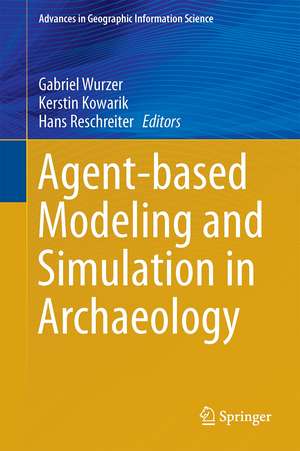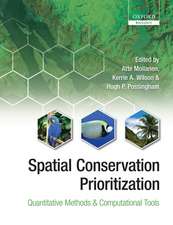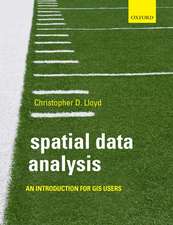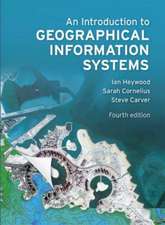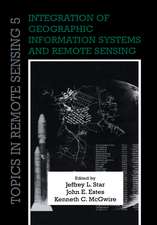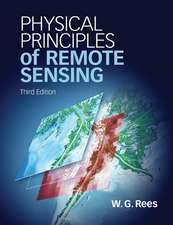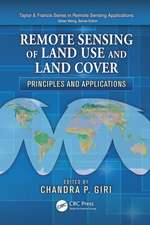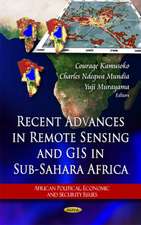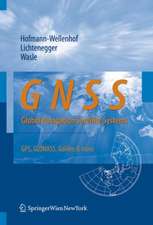Agent-based Modeling and Simulation in Archaeology: Advances in Geographic Information Science
Editat de Gabriel Wurzer, Kerstin Kowarik, Hans Reschreiteren Limba Engleză Hardback – 21 noi 2014
This situation has changed quite drastically with the advent of the internet age: Data, it seems, is now ubiquitous. Researchers have switched from simply collecting data to filtering, selecting and deriving insights in a cybernetic manner. Agent-based simulation is one of the tools used to glean information from highly complex excavation sites according to formalized models, capturing essential properties in a highly abstract and yet spatial manner. As such, the goal of this book is to present an overview of techniques used and work conducted in that field, drawing on the experience of practitioners.
| Toate formatele și edițiile | Preț | Express |
|---|---|---|
| Paperback (1) | 639.73 lei 6-8 săpt. | |
| Springer International Publishing – 23 aug 2016 | 639.73 lei 6-8 săpt. | |
| Hardback (1) | 646.11 lei 6-8 săpt. | |
| Springer International Publishing – 21 noi 2014 | 646.11 lei 6-8 săpt. |
Din seria Advances in Geographic Information Science
- 18%
 Preț: 1110.72 lei
Preț: 1110.72 lei - 24%
 Preț: 669.66 lei
Preț: 669.66 lei - 24%
 Preț: 606.73 lei
Preț: 606.73 lei - 15%
 Preț: 637.46 lei
Preț: 637.46 lei - 18%
 Preț: 899.21 lei
Preț: 899.21 lei - 18%
 Preț: 1388.68 lei
Preț: 1388.68 lei - 18%
 Preț: 948.92 lei
Preț: 948.92 lei - 15%
 Preț: 635.15 lei
Preț: 635.15 lei - 15%
 Preț: 635.96 lei
Preț: 635.96 lei - 18%
 Preț: 944.67 lei
Preț: 944.67 lei - 18%
 Preț: 954.31 lei
Preț: 954.31 lei - 15%
 Preț: 641.71 lei
Preț: 641.71 lei - 18%
 Preț: 1118.75 lei
Preț: 1118.75 lei - 15%
 Preț: 648.56 lei
Preț: 648.56 lei - 18%
 Preț: 1230.84 lei
Preț: 1230.84 lei - 18%
 Preț: 948.29 lei
Preț: 948.29 lei - 18%
 Preț: 1123.19 lei
Preț: 1123.19 lei - 18%
 Preț: 948.47 lei
Preț: 948.47 lei - 18%
 Preț: 956.69 lei
Preț: 956.69 lei - 18%
 Preț: 941.82 lei
Preț: 941.82 lei - 15%
 Preț: 635.80 lei
Preț: 635.80 lei - 18%
 Preț: 761.72 lei
Preț: 761.72 lei - 18%
 Preț: 894.03 lei
Preț: 894.03 lei
Preț: 646.11 lei
Preț vechi: 760.13 lei
-15% Nou
Puncte Express: 969
Preț estimativ în valută:
123.65€ • 128.61$ • 102.08£
123.65€ • 128.61$ • 102.08£
Carte tipărită la comandă
Livrare economică 15-29 aprilie
Preluare comenzi: 021 569.72.76
Specificații
ISBN-13: 9783319000077
ISBN-10: 3319000071
Pagini: 200
Ilustrații: XIV, 269 p. 60 illus., 46 illus. in color.
Dimensiuni: 155 x 235 x 17 mm
Greutate: 0.58 kg
Ediția:2015
Editura: Springer International Publishing
Colecția Springer
Seria Advances in Geographic Information Science
Locul publicării:Cham, Switzerland
ISBN-10: 3319000071
Pagini: 200
Ilustrații: XIV, 269 p. 60 illus., 46 illus. in color.
Dimensiuni: 155 x 235 x 17 mm
Greutate: 0.58 kg
Ediția:2015
Editura: Springer International Publishing
Colecția Springer
Seria Advances in Geographic Information Science
Locul publicării:Cham, Switzerland
Public țintă
ResearchCuprins
Introduction.- Explaining the past with ABM: on modeling philosophy.- Modeling archaeology: origins of the artificial Anasazi Project and beyond.- Agent-based simulation in archaeology: a characterization.- Reproducibility.- Geosimulation: modeling spatial processes.- Large simulations and small societies: high performance computing for archaeological simulations.- Mining with agents: modeling prehistoric mining and prehistoric economy.- Modeling settlement rank-size fluctuations.- Understanding the iron age economy: sustainability of agricultural practices under stable population growth.- Simulating Patagonian territoriality in prehistory: space, frontiers and networks among hunter-gatherers.- How did sugarscape become a whole society model?.
Recenzii
From the book reviews:
“Agent-based Modeling and Simulation in Archaeology provides a much-needed update, in one solid volume, on the methods and practice of using agent-based modeling to understand the past. … The most useful portion of this book to those new to agent-based modeling is probably the Methods section. … this book will be a worthwhile addition to our bookshelves, and I can already imagine incorporating it into courses in agent-based modeling.” (simulatingcomplexity, simulatingcomplexity.wordpress.com, February, 2015)
“Agent-based Modeling and Simulation in Archaeology provides a much-needed update, in one solid volume, on the methods and practice of using agent-based modeling to understand the past. … The most useful portion of this book to those new to agent-based modeling is probably the Methods section. … this book will be a worthwhile addition to our bookshelves, and I can already imagine incorporating it into courses in agent-based modeling.” (simulatingcomplexity, simulatingcomplexity.wordpress.com, February, 2015)
Notă biografică
Gabriel Wurzer is a computer scientist working on Agent-Based Simulation at Vienna University of Technology, in which field he is publishing, organizing workshops and holding lectures. Through cooperation with the Natural History Museum Vienna, he developed multiple models on prehistoric salt mining in the prehistoric mines of Hallstatt. Apart from Archaeology, he is also active in the field of Architectural planning, especially Hospital Simulation in the context of early design.
Kerstin Kowarik is an archaeologist working at the Natural History Museum Vienna specializing in the European Bronze Age and Early Iron Age. She is currently engaged with several research projects on the prehistoric salt mines of Hallstatt. Her research focuses on provisioning structures, organization of trade and human – environment interaction. She has a special interest in exploring the potential of computer based simulations for archaeological research, economic archaeology and environmental archaeology.
Hans Reschreiter is an archaeologist working at the Natural History Museum Vienna specializing in prehistoric crafts and technology as well as prehistoric mining. He is head of the archaeological excavations in the prehistoric salt mines of Hallstatt (Austria). His research focuses on working processes and mining technology. He has a special interest in prehistoric wood working, experimental archaeology and ethnoarchaeology.
Kerstin Kowarik is an archaeologist working at the Natural History Museum Vienna specializing in the European Bronze Age and Early Iron Age. She is currently engaged with several research projects on the prehistoric salt mines of Hallstatt. Her research focuses on provisioning structures, organization of trade and human – environment interaction. She has a special interest in exploring the potential of computer based simulations for archaeological research, economic archaeology and environmental archaeology.
Hans Reschreiter is an archaeologist working at the Natural History Museum Vienna specializing in prehistoric crafts and technology as well as prehistoric mining. He is head of the archaeological excavations in the prehistoric salt mines of Hallstatt (Austria). His research focuses on working processes and mining technology. He has a special interest in prehistoric wood working, experimental archaeology and ethnoarchaeology.
Textul de pe ultima copertă
Gabriel Wurzer is a computer scientist working on Agent-Based Simulation at Vienna University of Technology, in which field he is publishing, organizing workshops and holding lectures. Through cooperation with the Natural History Museum Vienna, he developed multiple models on prehistoric salt mining in the prehistoric mines of Hallstatt. Apart from Archaeology, he is also active in the field of Architectural planning, especially Hospital Simulation in the context of early design.
Kerstin Kowarik is an archaeologist working at the Natural History Museum Vienna specializing in the European Bronze Age and Early Iron Age. She is currently engaged with several research projects on the prehistoric salt mines of Hallstatt. Her research focuses on provisioning structures, organization of trade and human – environment interaction. She has a special interest in exploring the potential of computer based simulations for archaeological research, economic archaeology and environmental archaeology.
Hans Reschreiter is an archaeologist working at the Natural History Museum Vienna specializing in prehistoric crafts and technology as well as prehistoric mining. He is head of the archaeological excavations in the prehistoric salt mines of Hallstatt (Austria). His research focuses on working processes and mining technology. He has a special interest in prehistoric wood working, experimental archaeology and ethnoarchaeology.
Kerstin Kowarik is an archaeologist working at the Natural History Museum Vienna specializing in the European Bronze Age and Early Iron Age. She is currently engaged with several research projects on the prehistoric salt mines of Hallstatt. Her research focuses on provisioning structures, organization of trade and human – environment interaction. She has a special interest in exploring the potential of computer based simulations for archaeological research, economic archaeology and environmental archaeology.
Hans Reschreiter is an archaeologist working at the Natural History Museum Vienna specializing in prehistoric crafts and technology as well as prehistoric mining. He is head of the archaeological excavations in the prehistoric salt mines of Hallstatt (Austria). His research focuses on working processes and mining technology. He has a special interest in prehistoric wood working, experimental archaeology and ethnoarchaeology.
Caracteristici
A compilation of leading approaches used by practitioners in the field provides a rapid introduction and informs readers of the state of the art A focus on "re-usable concepts" makes it a work that will remain up-to date even years after publication, and will thus be preferred to "state of the art snapshots" Includes developments in archaeological ABM in graphical form Includes supplementary material: sn.pub/extras
